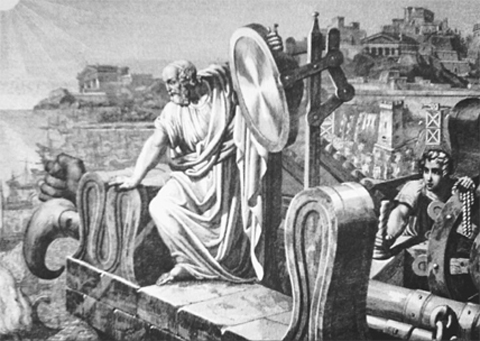How one old man held off an entire Roman fleet.
In 213 B.C., a Roman fleet under the command of Marcus Claudius Marcellus attacked the Greek city-state of Syracuse. Marcellus was confident he could take Syracuse in five days. Instead, it took more than a year, thanks to the ingenuity of one old man.
Archimedes.
Archimedes is best remembered for shouting “Eureka!” in his bath and running through the streets naked. But there was much more to the man than that. He was Einstein and Edison combined, the greatest scientist of the ancient world, and also a brilliant inventor. As the military adviser to the king of Syracuse, he spent years devising mysterious “engines” to protect the city. When the Romans came, Syracuse put Archimedes’ machines to work.
There were large catapults capable of hurling rocks the size of wagons, and small catapults called “scorpions” that shot darts at the Romans. A giant grappling claw lifted Roman ships by the bow and smashed them against the rocks. Mousetrap-like mechanisms levered giant weights down upon Roman siege ladders.
Then there were the mirrors.
Archimedes, according to several chroniclers, created a series of mirrors that could focus the sun’s energy on ships and cause them to burst into flame—a death ray in the ancient world.
Marcellus had to admit he could not take the city by storm. He was forced to lay siege to it for many months before he finally found a way in. Archimedes was killed in the sack of the city, but not before demonstrating that the genius of one man could prove equal to all the military might in Rome.
“ARCHIMEDES USES MY SHIPS TO LADLE SEAWATER INTO HIS WINE CUPS.”
— ROMAN GENERAL MARCUS CLAUDIUS MARCELLUS

Archimedes so terrorized Roman sailors that every time they spied a rope or a piece of wood sticking out from the walls of Syracuse, they feared it was another of his fearsome engines, and fled. “The Romans” said Plutarch, “began to think they were fighting with the gods.”
Numerous historians have expressed skepticism about the mirrors. But in 1747, French scientist George-Louis Leclerc de Buffon pulled off a successful demonstration of the technique. He used an array of mirrors to make a piece of wood two hundred feet away burst into flame. It was a great PR stunt that made him famous across Europe.